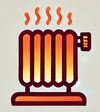If your propane heater won’t start or isn’t heating properly, check the fuel supply first. Ensure the propane tank is full and the valve is open. Next, inspect the ignition system and clean any debris that may be blocking the burner.
Understanding Propane Heaters
Propane heaters generate heat by burning propane fuel. It’s essential to know how they operate to troubleshoot effectively.
Types of Propane Heaters
- Portable Propane Heaters: These heaters are compact. You can move them easily from one room to another.
- Wall-Mounted Propane Heaters: These models stay fixed on walls. They save space and provide a steady heat source.
- Infrared Propane Heaters: These heaters emit infrared rays. They heat objects directly, which provides quick warmth.
- Ceramic Propane Heaters: These are efficient and often used for indoor spaces. They provide even heating without drying out the air.
- Home Heating: You can use propane heaters to warm living spaces. They’re popular for supplemental heat during cold months.
- Outdoor Heating: You can find propane heaters in patios and outdoor events. They extend outdoor seasons, providing comfort.
- Construction Sites: Propane heaters keep job sites warm. They ensure workers stay comfortable while completing tasks.
- Camping: Many campers choose portable propane heaters for warmth during cold nights. They enhance outdoor experiences by keeping you warm.
Initial Troubleshooting Steps
Troubleshooting a propane heater involves a few essential steps. Start by checking the basics to identify and resolve common issues.
Safety Precautions
- Always work in a well-ventilated area. Ensure there’s no risk of gas buildup.
- Wear protective gloves and goggles. These items protect against debris and accidents.
- Keep a fire extinguisher nearby. Be prepared for any unexpected flare-ups or emergencies.
- Turn off the gas supply before performing any repairs. This action prevents accidental gas release.
- Adjustable Wrench: Use it to tighten or loosen fittings and connections.
- Screwdriver Set: Different sizes are needed for accessing various components.
- Multimeter: Measure voltage for checking electrical connections.
- Needle or Small Wire: Clean the pilot tube if it becomes clogged.
- Flashlight: Bright light helps in inspecting hard-to-see areas.
These tools simplify the troubleshooting process and enhance safety while you work on your propane heater.
Common Issues with Propane Heaters
Propane heaters can encounter various issues. Understanding these common problems helps you troubleshoot effectively.
Ignition Problems
Ignition issues often stem from the pilot light or electronic system. If the pilot light doesn’t stay lit, check the thermocouple. It should be ⅔ covered by the flame. Adjust or replace it if it’s worn out or positioned too far away.
A clogged pilot tube might prevent ignition. Turn off the gas and clean the tube using a needle. Check for blockages in the gas supply line too. Insects or debris may obstruct the nozzle, stopping the pilot from lighting. Remove any blockages to restore function.
For electronic ignitions, ensure the gas cylinder isn’t empty and that the gas is turned on. Lack of gas flow prevents the heater from lighting successfully.
Insufficient Heat Output
If your heater isn’t producing enough heat, the problem may lie in the burner or gas flow. Inspect the burner for dirt or debris. A dirty burner can block heat output. Clean it thoroughly with a brush to ensure proper airflow.
Check the gas supply line for blockages. Turn off the gas and inspect the line for insects or material that could restrict gas flow. Clear any blockages to enhance heat output.
Also, verify that the heater is correctly sized for the space. An undersized heater may struggle to sufficiently warm your area.
Unusual Noises
Unusual noises often indicate issues with your heater’s components. Loud popping sounds can signify dirty burners that need cleaning. Remove debris and ensure proper operation to eliminate these noises.
Whistling sounds may suggest gas leaks or blockages in the supply line. Inspect connections and hoses for any cracks or damage. If you find a leak, repair or replace the affected parts immediately.
Listen for rattling or clanking noises, which could suggest loose parts. Tighten any screws or bolts on your heater to resolve these disturbances.
Detailed Troubleshooting Steps
Follow these steps to address common issues with propane heaters. Each step focuses on specific problems to help you quickly find solutions.
Step-by-Step Guide for Ignition Issues
- Check Gas Supply: Ensure the gas cylinder isn’t empty. Propane tanks might feel heavy even when low. Inspect the regulator. Detach the gas hose from the unit. Turn on the gas and check if gas flows through the hose. If gas doesn’t come out, look for blockages in the hose or regulator.
- Inspect the Pilot Light: If the pilot light won’t light, check for obstructions in the pilot tube. Use a needle to clear debris or insects that might block the flow. Ensure the pilot light flame reaches about one inch and burns blue. A yellow or orange flame indicates dirt buildup.
- Purge Trapped Air: If you suspect air in the gas lines, press and hold the control valve for 30 seconds. This action expels trapped air and helps ensure proper ignition.
- Examine Burner: If your heater struggles to produce heat, inspect the burner for debris. Dust and dirt can hinder performance. Clean the burner thoroughly to allow proper fuel flow.
- Inspect Gas Supply Line: Check the gas supply line for kinks or blockages. Clear any obstruction to restore gas flow. An open gas valve at the tank is essential for proper operation.
- Thermocouple Condition: Look at the thermocouple, the safety device that senses if the pilot light is on. If it’s dirty or misaligned, it may shut off the gas supply. Clean or reposition it for proper function.
- Adjust Temperature Settings: Verify the thermostat setting. It may be set too low. Increase the setting to see if the heater responds.
These steps guide you through diagnosing and fixing common propane heater issues effectively.
Maintenance Tips for Optimal Performance
Maintaining your propane heater ensures reliable and efficient operation throughout the heating season. Regular checks and seasonal preparations can keep your unit performing at its best.
Regular Checks and Cleaning
- Check the pilot light frequently. A steady flame indicates proper operation. If it’s out or flickering, inspect the pilot tube for blockages and clean it as needed.
- Inspect the burner regularly. Remove any debris that could obstruct airflow. A clean burner promotes efficient heating.
- Examine the gas supply line for leaks. Apply soapy water to connections. If you see bubbles, a leak exists. Tighten connections or replace faulty hoses.
- Replace or clean the air filter periodically. A clogged filter reduces airflow, affecting performance. Follow the manufacturer’s guidelines on replacement intervals.
- Test the thermostat settings. Ensure the heater responds to temperature adjustments. If it doesn’t, the thermostat may need recalibration or replacement.
- Before winter, check the propane tank level. A full tank guarantees consistent heating. Order a refill if the level is low.
- Inspect the heater’s exterior for damage. Look for rust or corrosion that could affect performance. Address any issues immediately to prevent further damage.
- Clean the area around the heater. Remove flammable materials and dust that could pose a safety hazard or impede airflow.
- Test the safety features at the beginning of the season. Ensure the emergency shut-off valve functions correctly. Confirm that all safety alarms are operational.
- Prepare your heater for storage if not in use. Empty the propane tank and store the heater in a dry place. Cover it to protect it from dust and moisture.
Implementing these maintenance tips keeps your propane heater running efficiently and safely.
Conclusion
Troubleshooting your propane heater doesn’t have to be overwhelming. By following the steps outlined in this guide you can quickly identify and resolve common issues. Regular maintenance is key to ensuring your heater operates efficiently and safely throughout the heating season.
Always prioritize safety by working in well-ventilated areas and using the right tools. With a little diligence and attention to detail you can enjoy the warmth and comfort your propane heater provides. Stay proactive with your maintenance and troubleshooting efforts to keep your heater in top shape for years to come.








